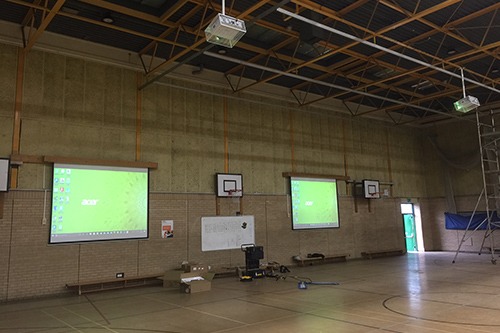Sizing and specifying audio visual systems for sports halls isn’t always straightforward because of the size and shape of the space.
Also, sports halls are enormous, and they are used in hundreds of different ways, from parent’s evenings to assemblies and shows, all requiring different AV qualities.
What we have, then, is a dynamic space that requires a dynamic audio visual solution that adapts to the demands of its audience. This article will cover several best practices to follow to create a great AV solution for sports halls.
Acoustic isolation
The audio in sports halls can bounce around, creating an echo chamber in an empty sports hall and a boom chamber in a packed sports hall. To counteract this, you can install acoustic panels on walls and acoustic ceiling hangers/tiles.
If your sports hall suffers from noise penetration, perhaps from corridors, this can also affect the audio experience. Doors should be insulated, and drywalls should be filled with an expandable foam that blocks high-frequency noise.
Speaker placement
Multi-speaker systems are better than central speaker systems in sports halls because they ensure everyone in the hall has ample sound.
The simplest setup is a wall speaker system, consisting of x8 or x12 4″ speakers spaced evenly across the walls. A standard setup is two speakers up front, two at the back, and four at both sides for a square/rectangular space.
A large central speaker can be paired with a wall-mounted multi-speaker system to fill larger sports halls, but this is not always needed.
Screen placement
Screens should be placed to accommodate the largest possible viewing audience. In a rectangular sports hall, this means placing the screen at the width end. Square sports halls can get away with placement on any wall – however, walls that do not receive direct sunlight are best to prevent unwanted reflections.
Depending on the space available, projector screens can be installed against a wall or float from the ceiling. Televisions and interactive displays should be mounted on the wall with a mount that offers angle adjustment so that the screen can be tilted.
Controlling the AV system
Speakers should be hooked up to a mixer amplifier, centralising all audio controls. The amplifier will come with an IR remote control, and some also have a companion smartphone app and Bluetooth, so you aren’t tied to a remote.
Screens will also have a remote control. However, if everything works via infrared, a universal remote may be preferred to bring all controls under one remote. Systems should be plugged into sockets that are safe and rated for the voltage. It’s also a good idea to have a surge protector extension leads to extend the lifespan of your electronics.
Need advice? We are here to help!
KPMS specialises in the design and installation of sports hall audio visual solutions. Advice is free, and we supply the biggest brands in the industry.
To find out more about our sports hall audio visual solutions, call our AV installation team on 01924 423 111 or email info@KPMS.co.uk.



